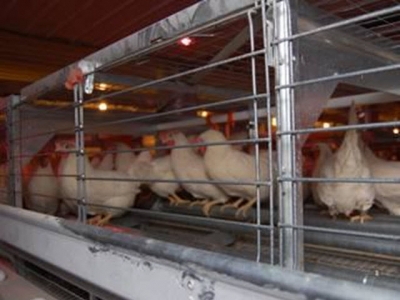Feed management for layers in enriched colonies

Layers in enriched colonies have more freedom to move around and interact with each other and their environment, and this is expected to increase their energy requirements.
Enriched colonies are gaining ground in countries outside the EU, where they have been enforced by law, but how to best feed hens in this new housing system remains a matter of discovery.
The recent transition in the European Union from battery cages to enriched colonies as a means of housing egg layers has created a number of questions regarding their nutrition. As with every change, observations and questions abound, but answers are away from being clear enough. Nevertheless, it is interesting to review the most common issues even at such preliminary stage, if only to increase awareness and cause further discussion.
- Activity. Layers in enriched colonies have more freedom to move around and interact with each other and their environment. As a logical consequence, it is expected their energy requirements will increase from 5 to 15 percent, depending on cage design and space allocation. Thus, when calculating expected feed intake based on previous records (from battery cages), it would be advisable to begin with a 10 percent extra allotment of feed towards this new "expenditure" on layer welfare. As long as body weight for age remains within established targets, there is no reason to alter this allotment, but any wide variation upwards or downwards should be followed by a quick recovery by an appropriate adjustment in total feed allowance. Keeping a close eye on body weight on a weekly basis will be of great help in maintaining target weight.
- Wastage. Feed in battery cages was wasted mainly when hens were over-consuming out of boredom. This was, of course, true in heavier birds with more generous appetites than in lighter strains of white-egg layers. In enriched colonies, this should not be a problem, as birds will have a great number of ways to keep themselves busy. But, as these new housing-feeding systems are relatively new, it is possible feed can be wasted due to insufficient feeder design. A high quality equipment manufacturer should have already taken this into account in their product design.
- Productivity. Some preliminary reports indicate that hens in enriched colonies might be able to reach higher productivity by 2 to 3 percentage points. This has been attributed to enhanced welfare and health status, but again, this is based on a limited number of studies. Nevertheless, if this is indeed the case, then high-peak feed should not be withdrawn too early. To this end, it is best to be a bit generous during the first couple cycles to reestablish a new productivity curve with any new housing-feeding system. In other words, do not change feeds before you see an actual cumulative drop of 2 to 3 percentage points in productivity.
- Body weight. As it might be surmised, some of the above issues call for increased feed intake. Yet, a number of modern highly productive white-egg strains support an extremely low mature body weight, and as a consequence, a very low appetite. Thus, the question becomes whether such strains as those developed for battery cages can cope in terms of appetite in enriched colonies. A possible answer can be the offering of more nutrient-dense feeds, but switching to a more robust genotype could also be considered. It should be expected that genetic suppliers would be looking into this issue in the next couple of years.
It should be evident by the nature of the questions and issues above that we are still unclear how to design an accurate feed program for layers housed in the new enriched colonies. Of course, under commercial settings, each operation is already testing various strategies depending on observed problems and available means. This is a new area in layer feed management that should be attracting significant attention in the coming years.

Some preliminary reports indicate that hens in enriched colonies might be able to reach higher productivity by 2 to 3 percentage points, so high-peak feed should not be withdrawn too early.
Related news
 Using maize gluten as an alternative protein source for poultry, pig feeds
Using maize gluten as an alternative protein source for poultry, pig feeds Maize gluten protein can replace part of soybean meal in diets, but like all ingredients, it has its positive and negative aspects that require attention during
 Smartphone app to let farmers test for poultry infection
Smartphone app to let farmers test for poultry infection System will help farmers act fast before disease can spread and potentially infect people.
 High-fiber diets for broiler versus layer chicks
High-fiber diets for broiler versus layer chicks Adding high-fiber ingredients in diets for layer chicks does not harm performance